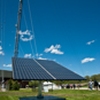Energy
Introduction
For most institutions, energy consumption is the largest source of greenhouse gas emissions, which cause global climate change. Implementing conservation measures and switching to renewable sources of energy can help institutions save money and protect them from utility rate volatility. Renewable energy may be generated locally and allow campuses to support local economic development. Furthermore, institutions can help shape markets by creating demand for cleaner, renewable sources of energy.
Featured Resources
Latest News from AASHE Bulletin
New Resources
Advanced Photovoltaic Educational Laboratory at Milwaukee Area Technical College
- Milwaukee Area Technical College (WI)
While originally focusing on reducing MATC's carbon footprint, the Photovoltaic Educational Laboratory has evolved into the Midwest's largest photovoltaic installation, generating 511 kWh DC and also serves as a lab …
- Posted June 25, 2010
- Case Studies
- View more
Integrating Teaching, Research and Operational Sustainability: Utilization of Bio-Energy at UNBC, Canada's Green University
- University of Northern British Columbia (BC)
In Spring 2009, UNBC installed Canada's first university owned wood pellet heating system. The project showcases the use of bio-energy as a sustainable, carbon-neutral energy source. UNBC's wood pellet system …
- Posted June 24, 2010
- Case Studies
- View more
Implementing Large Scale Solar in the Land of Cheap Coal
- Colorado State University (CO)
Colorado State University is home to one of the largest solar plants on a U.S. university campus. The fact that Colorado State has been able to expand renewable energy sources …
- Posted June 23, 2010
- Case Studies
- View more
Helping Small Businesses near Anderson University, SC
- Anderson University (SC)
Anderson University's SIFE team partnered with the local Sam's Club to help business members in efforts to help their facilities become environmentally friendly. We performed energy audits at these restaurants …
- Posted June 23, 2010
- Case Studies
- View more
WinterBlitz: Williams College students Weatherize Low-income Homes in the Local Community
- Williams College (MA)
For the past 2 years, Williams College students and community volunteers have weatherized a total of over 75 homes in 3 towns near Williams College during a one-day event in …
- Posted June 21, 2010
- Case Studies
- View more
Installing Occupancy Sensors at Missouri State University Residence Life and Services
- Missouri State University (MO)
Residence Life and Services at Missouri State University received a grant from City Utilities of Springfield, MO to install occupancy sensors on all lights in community and public restrooms, common …
- Posted June 17, 2010
- Case Studies
- View more
Student Activism Leads the Way to Clean Energy at Green Mountain College
- Green Mountain College (VT)
On April 22, 2010, Green Mountain College opened a new biomass facility to replace the power station that previously burned number six fuel oil. This new facility will reduce greenhouse …
- Posted June 14, 2010
- Case Studies
- View more
UO vs OSU Energy Civil War
- University of Oregon (OR)
The University of Oregon (UO) and Oregon State University (OSU) staged a human-powered energy generation contest to see which school could produce the most energy from their Recreation Centers' ReCardio …
- Posted June 8, 2010
- Case Studies
- View more
Holiday Energy Turn Down
- Emory University (GA)
During the 2009-2010 Winter Holiday break Emory University conducted a campaign to reduce energy consumption by turning down the HVAC for a total of six days in 15 buildings. These …
- Posted June 3, 2010
- Case Studies
- View more
This tab provides access to data collected through AASHE’s Sustainability Tracking, Assessment & Rating System™ (STARS). STARS is a transparent, self-reporting framework for colleges and universities to measure their sustainability performance. STARS enables meaningful comparisons over time and across institutions using a common set of measurements developed with broad participation from the campus sustainability community.
All responses reference content from reports under the latest version of STARS, version 2.2. AASHE membership and log-in is required.
OP 5: Building Energy Efficiency
- Total performance year site energy consumption per unit of floor area
- Total performance year source energy consumption per unit of floor area
- Percent reduction in total source energy consumption per unit of floor area from baseline
- Description of initiatives to shift individual attitudes and practices in regard to energy efficiency
- Description of energy use standards and controls employed by the institution
- Description of LED lighting and other energy-efficient lighting strategies
- Description of passive solar heating, geothermal systems, and related strategies
- Description of co-generation employed by the institution
- Description of initiatives to replace energy-consuming equipment with high efficiency alternatives
- Website URL - Energy conservation and efficiency program
OP 6: Clean and Renewable Energy
- Percent of total energy consumption from clean and renewable sources
- Website URL - Clean and renewable energy programs
- Percent of electricity from coal
- Percent of electricity from geothermal
- Percent of electricity from hydro
- Percent of electricity from natural gas
- Percent of electricity from nuclear energy
- Percent of electricity from solar photovoltaic
- Percent of electricity from wind
- Percent of electricity from wind
Additional analysis on scores and quantitative fields can be conducted using the STARS Benchmarking Tool.







